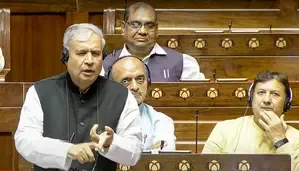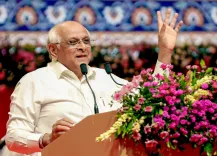Has Multidimensional Poverty in India Decreased from 29% to 11% in Just 9 Years?

Synopsis
Key Takeaways
- Multidimensional poverty rate fell from 29.17% to 11.28% in India over nine years.
- 24.82 crore people have escaped poverty during this period.
- The National Multidimensional Poverty Index measures multiple deprivations.
- Government initiatives have provided tap water to 16 crore households.
- Over 12 crore toilets have been constructed to improve sanitation.
New Delhi, July 23 (NationPress) The rate of multidimensional poverty in India, which encompasses not only food security but also access to essential health and education services, has reportedly decreased from 29.17 percent in 2013-14 to 11.28 percent in 2022-23. This signifies that an estimated 24.82 crore people have risen above the poverty line during this timeframe, as per data provided by NITI Aayog, announced by the Minister of State for Planning, Rao Inderjit Singh, in Parliament on Wednesday.
Furthermore, a separate report titled ‘National Multidimensional Poverty Index: A Progress Review 2023’, released by NITI Aayog, indicates that the percentage of individuals living in multidimensional poverty fell from 24.85 percent to 14.96 percent between 2015-16 and 2019-21, suggesting that approximately 13.5 crore people have escaped poverty during this period, the minister noted in a response to questions in the Lok Sabha.
The minister also highlighted that in 2021, the government introduced a detailed index called the National Multidimensional Poverty Index (MPI), designed to evaluate poverty by addressing overlapping deprivations in areas such as health, education, and living standards. This index incorporates 12 key indicators: nutrition, child and adolescent mortality, maternal health, years of schooling, school attendance, cooking fuel, sanitation, drinking water, electricity, housing, bank accounts, and assets. It assesses both the proportion of the population living in poverty and the extent of their deprivation. The second edition of this index was launched in 2023.
The government has also emphasized its achievements, such as providing tap water to 16 crore households and constructing 5 crore homes for economically disadvantaged families, as part of its initiatives aimed at enhancing the economic landscape of the nation and improving the living standards of its citizens.
Earlier, PM Modi remarked in Parliament that “despite 75 years of independence, 75 percent of households, totaling nearly 16 crore homes, lacked tap water connections. Within just five years, our government has managed to supply tap water to 12 crore families in their homes.”
He further noted that 4 crore houses have been allocated to the poorer sections of society, and over 12 crore toilets have been constructed to enhance the living conditions for citizens, particularly for women who have faced significant challenges due to a lack of these essential facilities.





